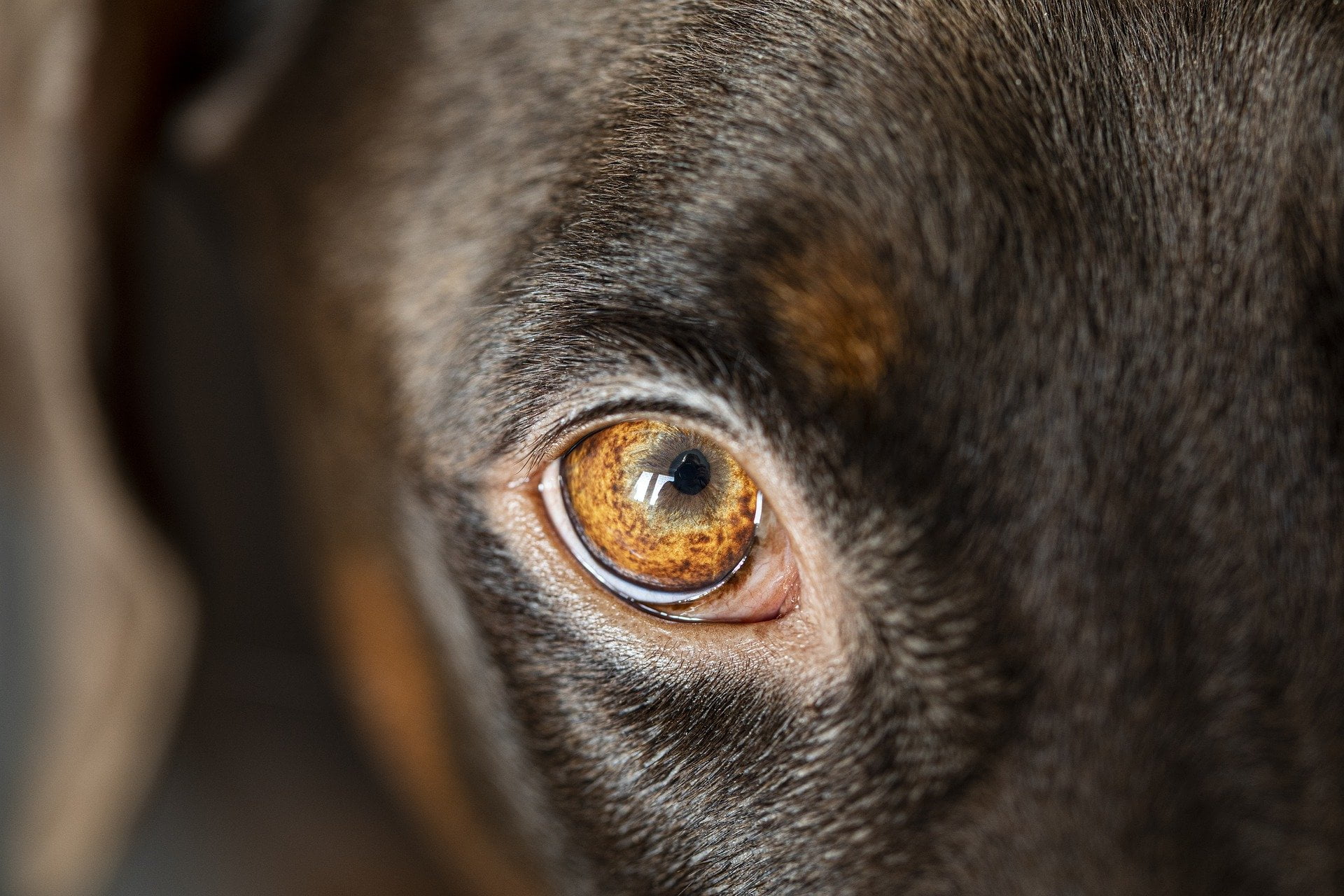Do you pay enough attention to your dog’s eye health and vision?
That’s an inevitable part of dog care – but still, pet parents tend to neglect some apparent symptoms.
A common problem that can escalate into something much more severe is dog blepharitis. If you haven’t heard of this condition before, it’s a type of eye inflammation with relatively common flare-ups that can further damage your dog’s sight.
It could end up being a painful condition – and experience – for both you and your pet.
It sounds pretty serious now, huh?
Well, that’s because it is.
Wondering how to recognize the signs and the most effective treatment methods for this health issue? I suggest that you stay until the end.
You’ll find it quite helpful, so scroll down!
Blepharitis In Dogs Explained: What Is Canine Blepharitis?

First, an explanation.
Canine blepharitis is, in simple terms, eyelid inflammation that attacks the eyes and the area around them. In some cases, blepharitis in dogs can include the surrounding tissue and Meibomian glands.
It can be pretty painful, and if not appropriately treated, dangerous to your dog’s sight.
Before I go into details, I guess you’d like to know if some dog breeds are at greater risk than others.
Generally, this health issue doesn’t apply to one particular dog breed. It can affect any dog breed and age, but experts have identified a critical group:
Dogs with prominent facial folds, short, flat faces, or extremely long and narrow muzzles are more prone to developing blepharitis.
You should be extra careful if you own one of the following breeds:
- Shih Tzus
- Pekingese
- Rottweilers
- English bulldogs
- Chow Chows
- Poodles
- Pugs
- Golden Retrievers
- Labrador Retrievers
If you are a pet owner of any of the breeds mentioned above, you should probably get them in the same room with you while you’re reading this.
Maybe even take a closer look at their eyes.
Like any other disease, blepharitis is curable if you notice the symptoms on time and take your dog to get proper treatment. Here, the emphasis is on alertness because the longer you wait, the more your dog’s eyesight will deteriorate.
Notice The Symptoms: Eye Inflammation & More

Since time is of the utmost importance here, you want to identify the initial symptoms as soon as possible. Look for these red flags:
- Intense itching of the eyes
- Constant scratching
- Loss of skin pigmentation around the eye area
- Inflammation of the cornea (blurred vision, excessive tear production)
- Flaky or scaly skin around the eyelids
- Loss of skin around the eye area
- Concurrent conjunctivitis
- Thickening of the eyelids
- Purulent discharge
- Pain around the eyelid margins
- Secondary bacterial infection
Important note:
There are cases in which developing blepharitis happens without any of the following symptoms. In that case, your doctor will most likely run extensive eye examination and blood tests (complete blood count) to find out the possible underlying cause of eye irritation.
And since we’re speaking of tests, here’s one you might need.
Schirmer Tear Test
Just because your dog’s eyes are not tearing up, that doesn’t mean your dog’s health isn’t compromised by eye inflammation or an underlying disease.
Luckily, there’s a way you can check this.
The Schirmer Tear Test, also known as STT, is a quick procedure that determines if your dog’s eyes produce enough tears.
Let’s say that this is a quick eye exam that can determine your dog’s eye health.
How Is The Schirmer Tear Test Performed?
Obviously, it starts with a trip to the vet.
Advancements in veterinary medicine made it possible for your vet to determine whether your dog’s eyes are healthy in less than 5 minutes.
And this is how it’ll play out:
Your vet is going to place two strips in the lower eyelids of your dog. It’s a special filter paper that shows the results after 60 seconds. The answer is in the measures indicated on those strips.
By comparing the amount of tears produced and eyelid involvement, the vet can determine whether your pup is suffering from keratoconjunctivitis sicca – or dry eye for short.
The palpebral conjunctiva covers both the inner and outer surface of the eyelid. Blepharitis in one eye is most common – but it can affect both eyes of your dog.
If this turns out to be positive, you won’t be needing further testing. Treating blepharitis is the next step.
Dog Allergy Swollen Eyes: Could It Be Just An Allergic Reaction?
Be careful not to get these two mixed up. Your dog’s eyes could also start watering due to seasonal or environmental allergies; external sources often cause eyelid abnormalities and inflammation.
You’re looking at the following possibilities:
- Cigarette smoke
- Pollen
- Harsh chemicals (house cleaning products)
- Dust mites
- Dander
- Strong colognes and perfumes
- Medications
- Environmental irritants
To be completely sure whether it’s allergies or KCS, you’ll need to take your dog to do a physical examination.
Have you noticed that your dog’s nose is runny, too? That might be another clue – and so could be any excess sneezing.
Is It Contagious?
Not for humans.
There’s no need to worry about catching this from your dog. You should be worried about your other pets, though.
If you have more than two pups in your household, and one of them had a positive STT, you should probably consider separating the two before the other one catches this.
If you live in an apartment, try finding a friend or relative that can dog-sit for a couple of days – or even weeks.
It all depends on the severity of the case and the underlying cause of blepharitis in dogs.
How Does It Spread?
Easy. Your dogs could just be playing for all you know.
The most common places where your dog can catch blepharitis are dog parks, where there are a lot of them in one place, licking each other and – well, dogs being dogs. It’s even more common during summer or spring.
However, dogs are not the only pets at risk of crusty dog eyelids; your cats and parrots could also get it.
What Are The Possible Causes?

It turns out there are many causes for this; the underlying cause can be virtually anything that leads to eyelid inflammation. Sometimes, it’s hard for vets to pinpoint an underlying cause, so they assume that it’s one of the following:
- Allergies (environmental, baby shampoo)
- Insect bites (staphylococcus hypersensitivity)
- Chemical burns
- Weak immune system
- Nutritional imbalances
- Endocrine abnormality
- Congenital abnormality
- Flaky skin
- Fungal infection, bacterial infection, parasite infection
- Solar irritation
Can traumatic injuries cause blepharitis?
Sure they can – but this is not number one on your list of causes. Your dog would have to be hurt badly. And if that happens, you shouldn’t postpone your vet appointment – you should call your vet ASAP.
There’s also blepharitis caused by tumors, which originates in the Meibomian glands.
Blepharitis In Dogs Treatment
The way you treat blepharitis depends heavily on the underlying cause, and since that’s sometimes hard to determine, pet parents resort to their first alternative: warm compresses.
It’s nothing too complicated; anyone can do it. You need some fresh and clean towels – or a cotton bowl – that have been soaked in warm water.
Pet owners use this to remove purulent discharge around the Meibomian gland.
That’s the most common and fastest, but unfortunately, not the most effective method out there. In severe cases, your dog is going to need more advanced treatment.
For example, bacterial blepharitis treatment will take a long time. You’ll probably need to give your dog prescribed antibiotics for three weeks. And you’ll also need to go to regular checkups.
Furthermore, some cases of idiopathic blepharitis are treated with topical medication, such as immunosuppressants.
Blepharitis Home Remedy?
We’ve already mentioned the most common blepharitis home treatment, and that’s warm compresses.
Another solution might involve eyelid dog scrubs, or eye drops that you can buy over the counter, or even baby shampoo – if your dog is not allergic to it, of course.
You can also ramp up your dog’s diet.
It’s not a guaranteed blepharitis dog cure. Still, it will undoubtedly help boost your dog’s immune system and lower the chances of viral infections, eye diseases, and even mast cell tumors.
Can You Prevent It?
You should know that blepharitis is not preventable. There are specific ways to lower the chances of your dog catching this – but nothing that will permanently prevent it.
If you’re still interested, here’s a couple of tips.
First thing’s first – basic dog hygiene. Make sure you bathe your pup regularly and clean its paws. They are the primary source of parasite infections that can directly cause this disease.
Wash your dog’s bed, and avoid harsh chemicals.
Do not deviate from the treatment recommended by your vet. Also, do not buy blepharitis antibiotics on your own – follow the instructions.
Once the affected eyelid becomes obvious, separate the infected dog from the non-infected one (if you have more pets, that is).
As I mentioned, certain dog breeds are more susceptible to this disease. So, if you happen to be the owner of one of them, I suggest a timely trip to the vet.
Final Thoughts
Okay, we’ve determined what dogs blepharitis refers to – now, let’s go over the essential facts one more time.
Canine blepharitis falls under the category of inflammatory disorders that attack your dog’s inner surface of the eyelid margin. Common symptoms of this condition are dog crusty eyelids, flaky skin, and bumps around dogs eyes. However, the presence of systemic disease, secondary inflammation, or congenital abnormalities could point to this disease, too. On that note, blepharitis can be caused by allergies, insect bites, solar irritation, the presence of an infectious agent; the list is long.
Finding the underlying cause is not easy, so vets rely on a couple of possible solutions.
There is more than one blepharitis cure. For mild cases, warm compresses can do the trick. On the other hand, severe cases require medication such as topical cyclosporine, topical ointment, oral doxycycline, topical antibiotics, or blepharitis eye drops.


